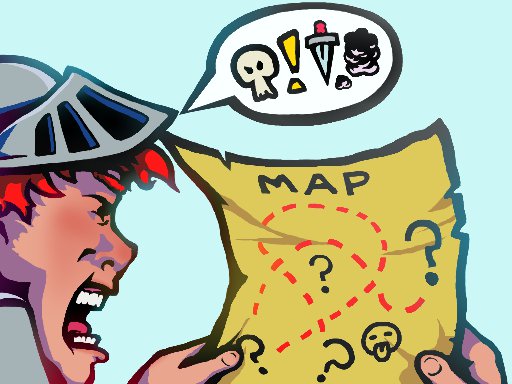
Break down your average exploration-heavy 2D platformer and you’ll find a very linear skeleton at the core of the experience. The Double-Jump will allow you to reach the ledge where you get the Flame Falcon, and that will melt the ice so you can reach the Hoverboard, and with that you can fly over the lava pit and reach the final boss.
As the level designer, it’s your job to see that the player hits these beats as smoothly as possible; but you also have to be sneaky about it because nobody appreciates a big, flashing, “This Way to the Final Boss!” sign on their epic adventure.
The following is a collection of subtle (time-consuming) features that will keep your players moving in the proper direction, or at the very least, hold their attention.
- Smaller is better
The ultimate tool for improving your game world is the delete button. If you’re ever unsure about a room’s purpose, delete it immediately. Be fearless when it comes to throwing away those areas you worked so hard on, because when it comes to the finished product, how hard you worked is irrelevant. What matters is the player’s personal experience playing the game, which has nothing to do with your personal experience making it.
- The distance between objectives
As a basic rule, the further apart your major items are, the more difficulty the player will have in locating them. Branching paths add to the challenge of navigation, as does hiding the objective within an area the player has already explored. Of course, depending on the manner in which you design your map, returning to an old area might be the simplest route for the player to understand and navigate.
Just consider this a guideline as you place what are essentially the chakra points of your game.
- Consistent macro-scale themes
Is your game world a cave? Then focus on altering the environment the deeper the player ventures. Is your game world a castle? Then place towers on the top and dungeons underneath.
I’m sure those examples seem painfully obvious, but remember that you need to view your macro theme through the player’s micro perspective. If you were a player with no prior experience and only travelled through ten rooms, would you have any idea where you were in the grand scheme of the game world? As you travel deeper into a cave does it feel like you’re going deeper?
Having rooms with a logical consistency does more than immerse the player. It helps them visualize their position on a macro scale, which in turn aids them in navigation.
- Familiarity and safety
Consider when the music stops upon entering a save room in Symphony of the Night; or how, right before you face a boss in Megaman, you have those, “Tick tick tick” doors and the empty hallway.
What's the purpose of that empty hallway?
Safer areas should possess a different atmosphere from the more dangerous ones. Whether this is through variety in music, backgrounds, or maybe different room elements (creepy statues right before a hazard zone are a nice touch), don’t half-ass the atmosphere of a room. Make it memorable and make it consistent. Do it right and your players will suffer Pavlovian reactions to the elements in your game world.

Mixing up the monsters in single rooms will give your game more variety during combat, but it also means that a monster who could’ve had a distinguishing location is now found in the same place where another one is located. Assigning the locals their own territories is (in these types of games) just as important as the combat itself. Players will pay attention to the types of monsters they fight more than any other asset in the game. You can change the color of the lichen, replace the torches with wisps, add some bats and new music; but the first thought in most players’ heads upon entering a new area is,
- Limited assets and you
Want to create memorable locations with limited assets? Then make your game smaller. If you stretch out your resources (a hundred rooms using this tileset, and another hundred using that tileset) then your game world isn’t going to be very memorable. Players will say things like, “It all looked the same.”
Conversely, if you use those same resources in a smaller game world then those different areas will have more of an impact on the player. You’ll make a better game by expending less effort.
Here’s some simple math: If your game has five different enemy types and seven different zones, delete three zones. Maybe four.
Actually, if your assets are that limited then you might want to drop the exploration aspect of your game altogether and create a more focused, linear experience.
- Diversity in gameplay
Never do the same puzzle twice. Don’t even bother with two puzzles that are sort of alike.
There are only so many ways you can set up the jumps in a vertical shaft. There are only so many ways you can organize the enemies to challenge the player. When you break this limit you’re just going to end up making the same rooms over and over, and that’ll kill a player’s sense of exploration faster than anything else.
It’s also a good idea to give yourself a robust, easy-to-implement scripting engine (no problem, right?). You’ll be able to add a lot more character to a room if you give it dynamic features like a randomized fog that signals the appearance of feral ghost cats, or a giant crab mini-boss that only shows up after discovering half the items in the game.
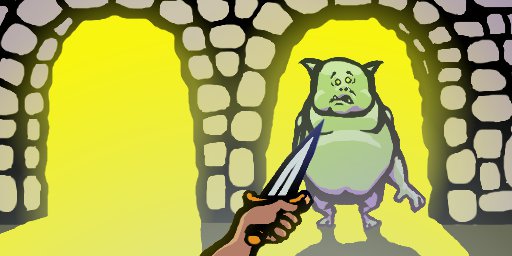
-Influencing the player (micro scale)
I’m talking about something more subtle than the starting town for a hack ’n slash, or a crowd of portals leading to all the different levels of a game. A hub is just a room that ties together all the surrounding rooms. Often, the hub will have an above-average number of doors, giving the player access to many different directions, and those paths are either going to lead the player to another hub, or back to the hub they just left.
The first dungeon in Ocarina of Time has two hubs: one for the main trunk, which is the first room you enter, and another just underneath, which you reach after mastering the first hub. The adjoining rooms always lead back to these hubs either directly or in a circuitous fashion. Due to their function, hubs end up as high-traffic areas for the players, so it’s best to keep the hazards to a minimum. Save the time-consuming obstacles for the rooms that lead to the treasure.
- Main Routes
Save all the treasure (and the challenging stuff) for the tertiary routes and dead-ends.
- Horizontal Passages
Combat flows better in horizontal passages. Both the player and the enemy will have more room to battle. Horizontal passages also make for better main routes. The player can travel left and right at an equal speed, unlike vertical passages where gravity plays a role (assuming there is gravity).
You can fit more doors onto a vertical passage, making them ideal hubs. Combat often doesn’t work as well in these areas, since jumping is the player’s main focus (assuming your game doesn’t have a jetpack), and it’s never fun to drop down onto an off-screen enemy and take damage you couldn’t avoid.
Enemies that take multiple hits are less practical in vertical passages.
- Teleporters
Contrary to what you might’ve been told by the purists, teleporters are not evil; but you should make an effort to avoid using them, or at the very least give them relevance in your game world, so they maintain the player’s sense of place (Super Metroid has some elevators and a pipes that serve as the equivalent of teleporters with limited direction).
Teleporters are an easy crutch for a designer to lean on, and a dungeon can lose its sense of depth and danger pretty fast if there’s a teleporter somewhere in the lower levels that leads all the way back to safety. The overall sense of structure for your game world can suffer if players are allowed to hop around the map and lose that hard-to-establish sense of place.
Be careful with teleporters.
- Anticipating player direction
Let’s take a look at one of my old maps.
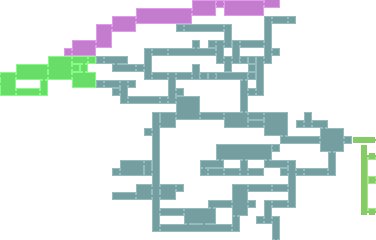
This is what I used to think passed for level design. At the time I never thought about plotting routes through my maps, but we’re going to do that right now.
Players will enter this area from the left, and if they want to make any progress, they’ll need to find their way to the end of this arrow.
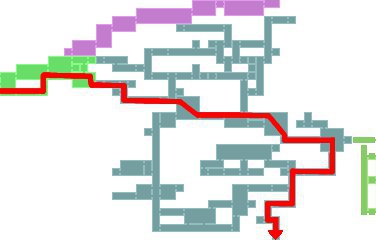
So if you didn’t have this red arrow for guidance (and assuming none of these passages were blocked), what would your chances be of finding your way through this maze?
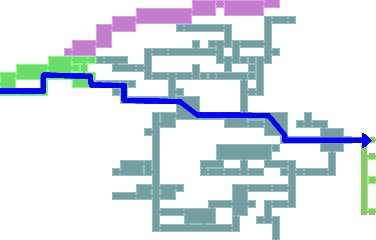
This blue line is the true main route of the map. This is where players were most likely to go, and it makes sense when you look at the (unintentional) theme of the map. When a player enters this area, they’re not going to see or know about any of these branching paths. To them, a doorway is just a doorway. On its own, it doesn’t mean anything, but every room a player travels through helps build an expectation in their mind of where they’re supposed to go. So if the first few rooms lead down-right, then the player is going to associate down-right with progress. If the player can’t associate a certain direction or theme with progress, then they won’t feel like they’re getting anywhere.
Remember that you’re both an architect and a guide. You build the world, but you also build the roads and the signs that are essential for your players to have fun during their adventure.
Anticipate their moves, guide them when they aren’t looking, and only use teleporters if you absolutely have to.


Excellent article. Probably the single largest influence on our game design has been seeing how our playtesters react. It doesn't matter how good you are at coding, art, or level design... there's a huge usability aspect that can't be anticipated until a human sits down and gives it a shot. This article really reflects the lessons you learn in those playtesting sessions
This is a *great* explanation of level design principles in exploration games! I just found this on the front page; I don't actually know what your game is yet, but I'm following it now. :)
does improve and give me a new outlook on level design. i mean, i still make linear 2d platformers for the most part but i do occasionally make something else.